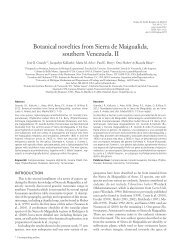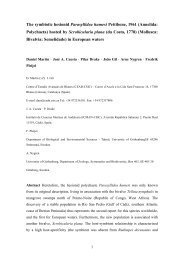FUNCTIONAL AND BIOACTIVE PROPERTIES OF COLLAGEN AND ...
FUNCTIONAL AND BIOACTIVE PROPERTIES OF COLLAGEN AND ...
FUNCTIONAL AND BIOACTIVE PROPERTIES OF COLLAGEN AND ...
You also want an ePaper? Increase the reach of your titles
YUMPU automatically turns print PDFs into web optimized ePapers that Google loves.
Saxena et al., 2005), and more recently from fish skins (Yang, Wang, Regenstein & Rouse, 2007;<br />
Wang, Yang & Regenstein, 2008; Yang, Wang, Zhou & Regenstein, 2008; Yang and Wang, 2009).<br />
The most abundant sources of gelatin are pig skin (46 %), bovine hide (29.4 %) and pork and cattle<br />
bones (23.1 %). Fish gelatin accounted for less than 1.5 % of total gelatin production in 2007, but this<br />
percentage was double that of the market data for 2002, indicating that gelatin production from<br />
alternative non-mammalian species had grown in importance (Gómez-Guillén, Pérez-Mateos,<br />
Gómez-Estaca, López-Caballero, Giménez & Montero, 2009). Apart from the well-known sociocultural<br />
and sanitary aspects, the rising interest in putting by-products from the fish industry to good<br />
use is one of the reasons why exploring different species and optimizing the extraction of fish gelatin<br />
has attracted the attention of researchers in the last decade (Gómez-Guillén et al., 2002; Karim &<br />
Bhat, 2009). The main drawback of fish gelatins is that gels based on them tend to be less stable and<br />
have worse rheological properties than gelatins from land mammals, and this may limit their field of<br />
application. Generally speaking, this is true in the case of cold-water fish species, such as cod,<br />
salmon, Alaska pollack, etc. Nevertheless, relatively recent studies have pointed out that tropical and<br />
sub-tropical warm-water fish species (tilapia, Nile perch, catfish) might have similar rheological<br />
properties and thermostability to that of mammal gelatins, depending on the species, type of raw<br />
material and processing conditions (Gilsenan & Ross-Murphy, 2000; Jamilah & Harvinder, 2002;<br />
Muyonga, Cole & Duodu, 2004b; Karim & Bhat, 2009; Gómez-Guillén et al., 2009; Rawdkuen, Sai-<br />
Ut, & Benjakul, 2010).<br />
Scientific literature about different alternative sources and new functionalities of collagen and gelatin<br />
has experienced a boom in the last 10-15 years, in part due to the growing interest in the economical<br />
valorisation of industrial by-products (from the meat and fish industry), the environmental friendly<br />
management of industrial wastes, and the search for innovative processing conditions as well as<br />
potential novel applications. Many of these improved functional properties are largely based on<br />
chemical- and enzymatic-induced cross-linking, as well as blending with other biopolymers.<br />
The classical food, photographic, cosmetic and pharmaceutical application of gelatin is based mainly<br />
on its gel-forming and viscoelastic properties. Recently, and especially in the food industry, an<br />
increasing number of new applications have been found for gelatin in products such as emulsifiers,<br />
foaming agents, colloid stabilizers, fining agents, biodegradable packaging materials and microencapsulating<br />
agents, in line with the growing trend to replace synthetic agents with more natural<br />
ones. Moreover, in many cases, these studies are dedicated to using collagens and gelatins from<br />
alternative sources to land-based animals.<br />
4

















